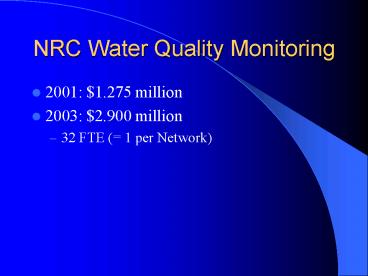NRC Water Quality Monitoring - PowerPoint PPT Presentation
1 / 15
Title:
NRC Water Quality Monitoring
Description:
Track and Support Attainment of NPS Servicewide Strategic (GPRA) Goals ... Information on 303-d listed waters. Information on ONRW or equivalent waters ... – PowerPoint PPT presentation
Number of Views:92
Avg rating:3.0/5.0
Title: NRC Water Quality Monitoring
1
NRC Water Quality Monitoring
- 2001 1.275 million
- 2003 2.900 million
- 32 FTE ( 1 per Network)
2
Purpose or NRC-WQ Monitoring
- Track and Support Attainment of NPS Servicewide
Strategic (GPRA) Goals - Protect pristine water quality (e.g., ONRW)
- Support additional ONRW listings in parks
- Improve Impaired Water Quality (303d-list)
- Support 303-d designations in parks
3
Fully integrate the design and implementation of
water quality monitoring with the Network Vital
Signs Monitoring design process
4
Networks Fully Funded in 01
- North Coast and Cascades
- Northeast Coastal and Barrier
- Hartland
- Sonoran Desert
- Cumberland/Piedmont
- Central Alaska
- National Capital
- Northern Colorado Plateau
- San Francisco Bay
- Southern Appalachian Highlands
- Greater Yellowstone
- Mediterranean Coast
5
Use Network Vital Signs Planning Process To
- Determine priorities for impaired water and
pristine water monitoring - Define site-specific monitoring
questions/objectives - Integrate with other Vital Signs monitoring
(e.g., Aquatic Resources, Air Resources) - Develop detailed monitoring plans
- Develop/coordinate implementation approaches
- NPS-Inhouse
- University (or other) Partnership
- USGS (or other) Partnership
- Other
6
Its up to individual networks to decide how to
proceed with
- Planning/Prioritization
- Design
- Implementation
- (WRD recommends spending up to 2 years in the
planning and design phases)
7
Examples of Network Approaches Planning and
Design
- Cooperative Agreements (No. Colo. Plateau,
Sonoran, NE Coast, Hartland) - Inhouse Hires (C.Alaska, NCR, GYELL,
N.Coast/Cascade, Cumberland/Pied.) - Baseline Inventories, Equipment Purchases
8
Examples of Planning/Design Phase Activities
- Pull together all existing WQ data
- Know what other monitoring activities are
on-going - Define most important water bodies from a Vital
Signs perspective - Information on 303-d listed waters
- Information on ONRW or equivalent waters
- Identify NPS candidate 303-d list waters
- Identify NPS candidate ONRW waters
- Identify significant water quality
stressors/threats - Prioritize water bodies for monitoring
- Develop site-specific monitoring
questions/objectives - Support synoptic studies in support of
statistical design
9
Guidance/Information From WRD
- -Water Quality Data Inventory and Analysis
Reports - -Level I Baseline Inventories (w/ IM Program)
- -Core set of required parameters
- -Protocols
- -Park-based data management shell/templates
- -Servicewide database management (STORET)
- -Guidance for monitoring plans, including QA/QC
- -Impaired water (303d-list) information
- -Fall (2001) coordination meeting (Fort Collins)
10
GUIDANCE UNDER DEVELOPMENT BY WRDWaters Not
Meeting Standards from 303d lists
11
GUIDANCE IN DEVELOPMENT BY WRDIdentification of
Outstanding National Resource Waters
12
GUIDANCE IN DEVELOPMENT BY WRD
- Water Quality, Contaminants, and Aquatic Biology
- Vital Signs Monitoring Under the Natural Resource
Challenge - Long-Term Water Quality Monitoring Program
- Draft
- Guidance on
- WRD Required and Other Field Parameter
Measurements
13
GUIDANCE IN DEVELOPMENT BY WRDREQUIRED
PARAMETERS AND METHODS
14
Data Management
- Park/Network
- Excel/Access Database Templates
- Park/Network-based GIS TA
- National
- Servicewide NPS WQ database in STORET
- Uploading Service
- Data accessible (NPS and others) on web
- Triennial synthesis reports
15
Data Management Reporting
Data Elements for Reporting Water Quality
Results of Chemical and Microbiological Analytes
Who? What? Where? When? Why? How?
Water Quality Metadata































